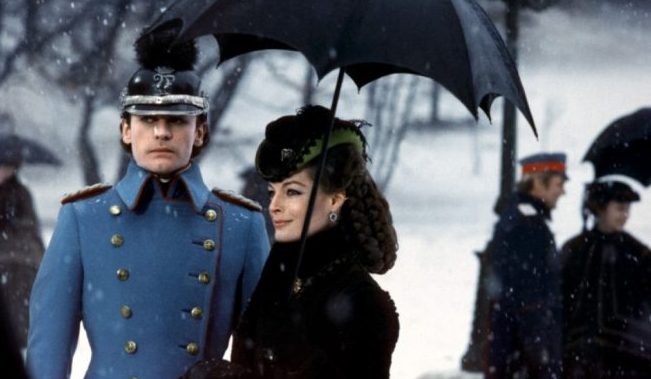
Ludwig (1972) Blu-ray Review

The running theme through all of Luchino Visconti’s later films is the decadence among opulent old money and aristocracy. In Il Gattopardo (The Leopard) (1963), a Sicilian nobleman tries to preserve his fiefdom during the creation of the Italian Republic, in Vaghe stella dell’Orsa (Sandra) (1964) secrets of past incest haunt an Italian villa in Volterra, in The Damned (1969) an old industrialist Bavarian family become seduced by the Nazis whilst incest also looms in the families dark shadows, in Death in Venice (1971) a composer on holiday in Venice allows his obsession with a teenage boy to blind him to the cholera epidemic in the city and in his final film, L’Innocente (1976) an arrogant aristrocrat is a womaniser. The great epic of Visconti’s later career is Ludwig (1972), the story of the young effete and selfish King Ludwig II of Bavaria whose obsessions with the composer Richard Wagner and his increasing eccentricities and follies haemmoraged money out of the Bavarian state at the expense of the people and led to his downfall. At 257 minutes the film is indeed epic in length and the mise-en-scène of each scene is rich with the trappings of that opulence. There are two versions on these discs: the longer four part Italian television screened version and the 242 minute theatrical release.
The film opens with a grand ceremony with the lavish looking King Ludwig (Helmut Berger) dressed in Ruritanian costume and donning an ermine robe at his coronation. The new king is 19-years-old and little interested in the people or the affairs of state and more concerned with the trappings of royalty. Even when Bavaria is in a disastrous war with Prussia he shows little interest or concern. He is having an affair and is in love with his first cousin, Princess Elizabeth of Austria (Romy Schneider). She withdraws from him and suggests that her younger sister, Sophie (Sonia Petrovna) would make a good Queen. Ludwig’s one main obsession at this time is the composer Richard Wagner (Trevor Howard) who he invites to Munich with his mistress, Cosima (Silvana Mangano). The large amount of money expended on Wagner leads to the composer being hounded out of Munich much to the king’s chagrin. The longer Ludwig is in power the more he becomes divorced from reality and withdrawn from the court. He focuses his attentions back on Wagner, on his palace and castle building projects and slowly becomes withdrawn from society. He also refuses to marry Sophie and gives way to his homosexual desires.
In Bavaria images of Ludwig II are everywhere. He is still revered as though he were still the reigning monarch. He is also an example that you never truly get rid of monarchy unless you have something solid to replace it with (monarchy was abolished in Germany after the First World War). Yet King Ludwig II, at the time he ruled (he was king from 1864 – 1886), was not very popular with the people whose taxes were spent on his ambitious castles and palace projects. Today, however, these projects are among Germany’s top visitor attractions and annually generate millions of euros for German tourism. The tourist shops are filled with images of Ludwig or images of his castles on all sorts of tat. In the film Ludwig is perfectly played by the Austrian actor Helmut Berger. He looks and behaves the part: from his hair, his rotten teeth to the clothes. Berger is a regular in Visconti’s films and was a lover of the meister director. He brings to the role an accurate decadent capricious selfishness. In a word he is perfectly cast. Elements of this character and charisma can still be seen on the interview with Berger on the disc where he displays some of this eccentric arrogance. Other members of the cast are also perfect including Schneider who once again played Princess Elizabeth, best known, particularly in Europe for playing this role 3 times before in the Sissi trilogy. Trevor Howard looks the spitting image of Wagner, but perhaps he could have been a little more charismatic than he is played here. The film benefits too from being shot at the real locations, the actual castles and palaces in Bavaria Ludwig built and lived in.
The language in some films from the 1960s and early 70s international films posed a problem – what language to watch the film in. In the UK Brits will rarely accept dubbed films. They often had an international cast, with Visconti’s films particularly posing a problem. Languages available on this presentation are in both Italian and British. It would be my strong advice to watch it in English rather than Italian as the films dialogue was originally recorded in English although on this disc it did drift on the audio track from English to Italian and back again throughout. In an interview on the disc with Berger he recounts that Ludwig was filmed and recorded in English but he was not available to record either the Italian or German dialogue due to other film commitments.
In Germany this film is often shown and does the rounds in Munich in smaller independent cinemas. It has also spawned many other film versions for the cinema and TV, the most recent cinema release in Germany being in 2012. Visconti’s film is by far the most superior and, if the viewer can withstand the more than 4 hour epic length it is worth the journey. However, as a big Visconti fan who lived in Munich for several years I am biased. The film also benefits from shooting throughout at the original locations, exterior and interiors, which have changed little from when they habited by Bavarian monarchy.
As well as the theatrical and television presentations on the disc there are also documentaries on Visconti and Silvana Mangano as well as recently recorded interviews with Berger and the film’s German producer, Dieter Geissler.
Chris Hick
